-

新人教版高中英语选修2Unit 3 Food and Culture-Discovering useful structures教学设计
The newspaper reported more than 100 people had been killed in the thunderstorm.报纸报道说有一百多人在暴风雨中丧生。(2)before、when、by the time、until、after、once等引导的时间状语从句的谓语是一般过去时,以及by、before后面接过去的时间时,主句动作发生在从句的动作或过去的时间之前且表示被动时,要用过去完成时的被动语态。By the time my brother was 10, he had been sent to Italy.我弟弟10岁前就已经被送到意大利了。Tons of rice had been produced by the end of last month. 到上月底已生产了好几吨大米。(3) It was the first/second/last ... time that ...句中that引导的定语从句中,主语与谓语构成被动关系时,要用过去完成时的被动语态。It was the first time that I had seen the night fact to face in one and a half years. 这是我一年半以来第一次亲眼目睹夜晚的景色。(4)在虚拟语气中,条件句表示与过去事实相反,且主语与谓语构成被动关系时,要用过去完成时的被动语态。If I had been instructed by him earlier, I would have finished the task.如果我早一点得到他的指示,我早就完成这项任务了。If I had hurried, I wouldn't have missed the train.如果我快点的话,我就不会误了火车。If you had been at the party, you would have met him. 如果你去了晚会,你就会见到他的。

新人教版高中英语选修2Unit 4 Journey Across a Vast Land教学设计
当孩子们由父母陪同时,他们才被允许进入这个运动场。3.过去分词(短语)作状语时的几种特殊情况(1)过去分词(短语)在句中作时间、条件、原因、让步状语时,相当于对应的时间、条件、原因及让步状语从句。Seen from the top of the mountain (=When it is seen from the top of the mountain), the whole town looks more beautiful.从山顶上看,整个城市看起来更美了。Given ten more minutes (=If we are given ten more minutes), we will finish the work perfectly.如果多给十分钟,我们会完美地完成这项工作。Greatly touched by his words (=Because she was greatly touched by his words), she was full of tears.由于被他的话深深地感动,她满眼泪花。Warned of the storm (=Though they were warned of the storm), the farmers were still working on the farm.尽管被警告了风暴的到来,但农民们仍在农场干活。(2)过去分词(短语)在句中作伴随、方式等状语时,可改为句子的并列谓语或改为并列分句。The teacher came into the room, followed by two students (=and was followed by two students).后面跟着两个学生,老师走进了房间。He spent the whole afternoon, accompanied by his mom(=and was accompanied by his mom).他由母亲陪着度过了一整个下午。

新人教版高中英语选修2Unit 5 First Aid-Discovering useful structures教学设计
You have no excuse for not going.你没有理由不去。He was punished for not having finished his homework.他因未完成作业而受到惩罚。2.动词ing形式复合结构由物主代词或人称代词宾格、名词所有格或普通格加动词ing,即“sb./sb.'s+doing”构成。动词ing形式的复合结构实际上是给动词ing形式加了一个逻辑主语。动词ing形式的复合结构有四种形式:①形容词性物主代词+动词ing②名词所有格+动词ing③代词宾格+动词ing④名词+动词ingHer coming to help encouraged all of us.她来帮忙鼓舞了我们所有人。The baby was made awake by the door suddenly shutting.这个婴儿被突然的关门声吵醒了。Can you imagine him/Jack cooking at home?你能想象他/杰克在家做饭的样子吗?无生命名词无论是作主语还是作宾语都不能用第②种形式。Tom's winning first prize last year impressed me a lot.汤姆去年得了一等奖使我印象深刻。Do you mind my/me/Jack's/Jack leaving now?你介意我/杰克现在离开吗?Excuse me for my not coming on time.很抱歉我没能按时来。His father's being ill made him worried.他父亲病了,他很担心。We are looking forward to the singer's/the singer to give us a concert.我们盼望着这位歌手来给我们举办一场演唱会。

新人教版高中英语选修2Unit 1 Science and Scientists-Discovering useful structures教学设计
The grammatical structure of this unit is predicative clause. Like object clause and subject clause, predicative clause is one of Nominal Clauses. The leading words of predicative clauses are that, what, how, what, where, as if, because, etc.The design of teaching activities aims to guide students to perceive the structural features of predicative clauses and think about their ideographic functions. Beyond that, students should be guided to use this grammar in the context apporpriately and flexibly.1. Enable the Ss to master the usage of the predicative clauses in this unit.2. Enable the Ss to use the predicative patterns flexibly.3. Train the Ss to apply some skills by doing the relevant exercises.1.Guide students to perceive the structural features of predicative clauses and think about their ideographic functions.2.Strengthen students' ability of using predicative clauses in context, but also cultivate their ability of text analysis and logical reasoning competence.Step1: Underline all the examples in the reading passage, where noun clauses are used as the predicative. Then state their meaning and functions.1) One theory was that bad air caused the disease.2) Another theory was that cholera was caused by an infection from germs in food or water.3) The truth was that the water from the Broad Street had been infected by waste.Sum up the rules of grammar:1. 以上黑体部分在句中作表语。2. 句1、2、3中的that在从句中不作成分,只起连接作用。 Step2: Review the basic components of predicative clauses1.Definition

新人教版高中英语选修2Unit 1 Science and Scientists-Learning about Language教学设计
Step 7: complete the discourse according to the grammar rules.Cholera used to be one of the most 1.__________ (fear) diseases in the world. In the early 19th century, _2_________ an outbreak of cholera hit Europe, millions of people died. But neither its cause, 3__________ its cure was understood. A British doctor, John Snow, wanted to solve the problem and he knew that cholera would not be controlled _4_________ its cause was found. In general, there were two contradictory theories 5 __________ explained how cholera spread. The first suggested that bad air caused the disease. The second was that cholera was caused by an _6_________(infect) from germs in food or water. John Snow thought that the second theory was correct but he needed proof. So when another outbreak of cholera hit London in 1854, he began to investigate. Later, with all the evidence he _7_________ (gather), John Snow was able to announce that the pump water carried cholera germs. Therefore, he had the handle of the pump _8_________ (remove) so that it couldn't be used. Through his intervention,the disease was stopped in its tracks. What is more, John Snow found that some companies sold water from the River Thames that __9__________________ (pollute) by raw waste. The people who drank this water were much more likely _10_________ (get) cholera than those who drank pure or boiled water. Through John Snow's efforts, the _11_________ (threaten) of cholera around the world saw a substantial increase. Keys: 1.feared 2.when 3. nor 4.unless 5.that/which 6.infection 7.had gathered 8.removed 9.was polluted 10.to get 11. threat

新人教版高中英语选修2Unit 1 Science and Scientists-Reading and thinking教学设计
Step 5: After learning the text, discuss with your peers about the following questions:1.John Snow believed Idea 2 was right. How did he finally prove it?2. Do you think John Snow would have solved this problem without the map?3. Cholera is a 19th century disease. What disease do you think is similar to cholera today?SARS and Covid-19 because they are both deadly and fatally infectious, have an unknown cause and need serious public health care to solve them urgently.keys:1. John Snow finally proved his idea because he found an outbreak that was clearly related to cholera, collected information and was able to tie cases outside the area to the polluted water.2. No. The map helped John Snow organize his ideas. He was able to identify those households that had had many deaths and check their water-drinking habits. He identified those houses that had had no deaths and surveyed their drinking habits. The evidence clearly pointed to the polluted water being the cause.3. SARS and Covid-19 because they are both deadly and fatally infectious, have an unknown cause and need serious public health care to solve them urgently.Step 6: Consolidate what you have learned by filling in the blanks:John Snow was a well-known _1___ in London in the _2__ century. He wanted to find the _3_____ of cholera in order to help people ___4_____ it. In 1854 when a cholera __5__ London, he began to gather information. He ___6__ on a map ___7___ all the dead people had lived and he found that many people who had ___8____ (drink) the dirty water from the __9____ died. So he decided that the polluted water ___10____ cholera. He suggested that the ___11__ of all water supplies should be _12______ and new methods of dealing with ____13___ water be found. Finally, “King Cholera” was __14_____.Keys: 1. doctor 2. 19th 3.cause 4.infected with 5.hit 6.marked 7.where 8.drunk 9.pump 10.carried 11.source 12.examined 13.polluted 14.defeatedHomework: Retell the text after class and preview its language points

新人教版高中英语选修2Unit 2 Bridging Cultures-Discovering useful structures教学设计
The grammar of this unit is designed to review noun clauses. Sentences that use nouns in a sentence are called noun clauses. Nominal clauses can act as subject, object, predicate, appositive and other components in compound sentences. According to the above-mentioned different grammatical functions, nominal clauses are divided into subject clause, object clause, predicate clause and appositive clause. In this unit, we will review the three kinds of nominal clauses. Appositive clauses are not required to be mastered in the optional compulsory stage, so they are not involved.1. Guide the students to judge the compound sentences and determine the composition of the clauses in the sentence.2. Instruct students to try to learn grammar by generalizing grammar rules, controlling written practice, and semi-open oral output.3. Inspire the students to systematize the function and usage of noun clause1.Instruct students to try to learn grammar by generalizing grammar rules, controlling written practice, and semi-open oral output.2.Inspire the students to systematize the function and usage of noun clauseStep1: The teacher ask studetns to find out more nominal clauses from the reading passage and udnerline the nominal clauses.

新人教版高中英语选修2Unit 3 Food and Culture-Reading and thinking教学设计
The discourse explores the link between food and culture from a foreign’s perspective and it records some authentic Chinese food and illustrates the cultural meaning, gerography features and historic tradition that the food reflects. It is aimed to lead students to understand and think about the connection between food and culture. While teaching, the teacher should instruct students to find out the writing order and the writer’s experieces and feelings towards Chinese food and culture.1.Guide the students to read the text, sort out the information and dig out the topic.2.Understand the cultural connotation, regional characteristics and historical tradition of Chinese cuisine3.Understand and explore the relationship between food and people's personality4.Guide the students to use the cohesive words in the text5.Lead students to accurately grasp the real meaning of the information and improve the overall understanding ability by understanding the implied meaning behind the text.1. Enable the Ss to understand the structure and the writing style of the passage well.2. Lead the Ss to understand and think further about the connection between food and geography and local character traits.Step1: Prediction before reading. Before you read, look at the title, and the picture. What do you think this article is about?keys:It is about various culture and cuisine about a place or some countries.
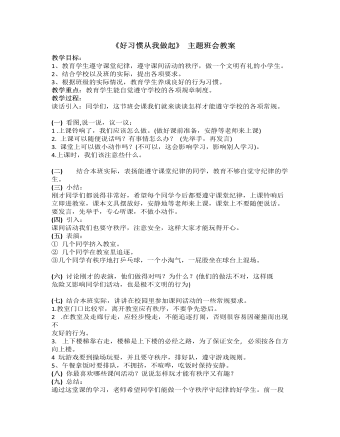
《好习惯从我做起》主题班会教案
教学目标:1、教育学生遵守课堂纪律,遵守课间活动的秩序,做一个文明有礼的小学生。2、结合学校以及班的实际,提出各项要求。3、根据班级的实际情况,教育学生养成良好的行为习惯。教学重点:教育学生能自觉遵守学校的各项规章制度。教学过程:谈话引入:同学们,这节班会课我们就来谈谈怎样才能遵守学校的各项常规。(一) 看图,说一说,议一议:1 .上课铃响了,我们应该怎么做。(做好课前准备,安静等老师来上课)2. 上课可以随便说话吗?有事情怎么办? (先举手,再发言)3. 课堂上可以做小动作吗?(不可以,这会影响学习,影响别人学习)。4.上课时,我们该注意些什么。(二) 结合本班实际,表扬能遵守课堂纪律的同学,教育不够自觉守纪律的学生。(三) 小结:刚才同学们都说得非常好,希望每个同学今后都要遵守课堂纪律,上课铃响后立即进教室,课本文具摆放好,安静地等老师来上课,课堂上不要随便说话。要发言,先举手,专心听课,不做小动作。
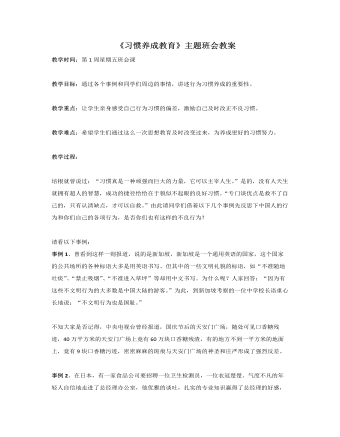
《习惯养成教育》主题班会教案
事实上,良好的行为习惯,是保证我们顺利学习的前提,也是树立健康人格的基础。在学校没有良好的行为习惯的同学就可能目无纪律,不讲卫生,扰乱班级的学习环境。相反,如果我们养成了文明的行为习惯,学习环境就一定是良好的、有序的。我们知道:一个学校的学生具有良好的文明行为习惯,才能构建出优良的学习环境,创设出优良的学习气氛。现在,我们正处于人生中最关键的成长时期,我们在这个时期的所作所为,将潜移默化的影响到我们自身的心理素质,而文明的行为就在帮助我们提高自身的心理素质,同时也完善了自身的道德品质,如果我们不在此时抓好自身道德素质的培养,那我们即使拥有了丰富的科学文化知识,于人于己于社会又有何用呢?所以,我们首先应该做一个堂堂正正的人,一个懂文明、有礼貌的谦谦君子,然后才是成才,不能做一部单纯掌握知识技能的机器,而要成为一个身心和谐发展的人。文明就是我们素质的前沿,拥有文明,那我们就拥有了世界上最为宝贵的精神财富。行为习惯的表现优异,也能在学风建设中反映出来。
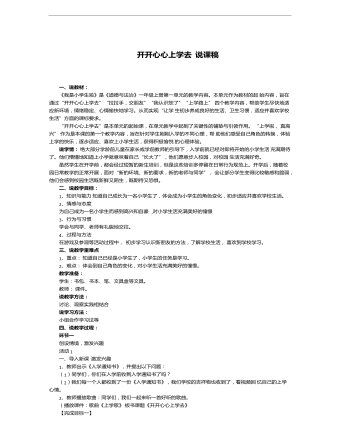
开开心心上学去 说课稿
一、说教材:《我是小学生啦》是《道德与法治》一年级上册第一单元的教学内容。本单元作为教材的起始内容,旨在通过“开开心心上学去”“拉拉手,交朋友”“我认识您了”“上学路上”四个教学内容,帮助学生尽快地适应新环境,情绪稳定、心情愉快地学习。从而实现“让学生初步养成良好的生活、卫生习惯,适应并喜欢学校生活”方面的课标要求。“开开心心上学去”是本单元的起始课,在单元教学中起到了关键性的铺垫与引领作用。“上学啦,真高兴”作为是本课的第一个教学内容,旨在针对学生刚刚入学的不同心理,帮助他们感受自己角色的转换,体验上学的快乐,逐步适应、喜欢上小学生活,获得积极愉悦的心理体验。说学情:绝大部分学龄前儿童在家长或学前教师的引导下,入学前就已经对即将开始的小学生活充满期待了。他们懵懂地知道上小学就意味着自己“长大了”,他们愿意步入校园,对校园生活充满好奇。虽然学生在开学前,都会经过短暂的新生培训,但是这些培训多停留在日常行为规范上。开学后,随着校园日常教学的正常开展,面对“新的环境、新的要求,新的老师与同学”,会让部分学生变得比较敏感和脆弱,他们会感到校园生活既新鲜又陌生,既期待又恐惧。二、说教学目标:1、知识与能力知道自己成长为一名小学生了,体会成为小学生的角色变化,初步适应并喜欢学校生活。2、情感与态度为自己成为一名小学生而感到高兴和自豪 ,对小学生活充满美好的憧憬3、行为与习惯学会与同学、老师有礼貌地交往。4、过程与方法在游戏及参观等活动过程中,初步学习认识新朋友的方法,了解学校生活,喜欢到学校学习。
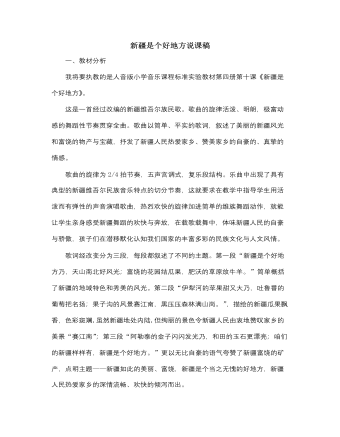
人音版小学音乐二年级下册新疆是个好地方说课稿
在学生热烈的讨论中,理解歌词,感悟新疆。并随机出示课件(课题 新疆是个好地方以及天山、伊犁河、吐鲁番、果子沟的图片)教师及时小结“在新疆这片美丽的土地上,大自然也创作出了它的杰作,用它那神奇的力量,为新疆人民开辟了一处圣地——天山。天山是新疆最大的一条山脉,峰顶白雪皑皑。它是新疆的象征。”在引领学生有感情的朗读歌词时,重点指导学生“乃”字要读轻声才好听。学生按节奏读第二段歌词,教师告诉提醒学生注意一字多音的地方要读正确,如“伊犁河”“果子沟的”等。再次,教师有感情地范唱。教师用语言调动学生的积极性,如“大家读的真有感情,我都忍不住要唱起来了,大家想听吗?如果你觉得老师唱的好听就请拍手为我伴奏吧!”“老师唱的好听吗?相信你们比老师唱的更好听,想不想跟我比一比啊?”
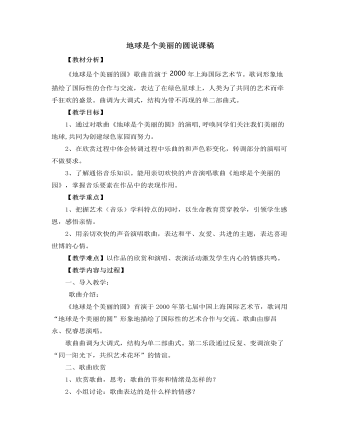
人音版小学音乐五年级下册地球是个美丽的圆说课稿
2、唱准歌曲:出示歌曲总谱生再次聆听歌曲,熟悉歌曲内容,给乐曲分段。3、节奏学习学会给乐曲分乐段,注意呼吸记号处,降A调的认识。四四拍的打法及练习。4、学唱旋律:教师范唱,学生分小组自学,可以借助课堂乐器帮助。5、填词演唱学生朗诵歌词,再听歌曲,看歌词轻唱感受歌曲。6、学生轻声跟琴演唱歌曲,教师适当指导。说明:用自然、明亮的声音,以及积极的歌唱状态轻松自如地进行歌唱。演唱时注意八度跳进的音准。7、集体演唱,并配上简单的动作(牵手、挥手、左右晃动身体)生生互演分组演唱小组合作四、小结:让我们在爱的世界中感恩;让我们与爱同行;让世界充满爱。教学反思:《地球是个美丽的圆》:“地球”代表大自然,美丽的“圆”正是人们所向往的。在本节课上,我以地球为载体,以感受大自然、保护大自然、热爱生活为主线,通过看、听、赏、唱、创、演来展开教学。
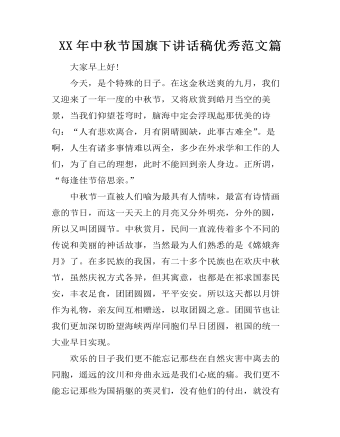
XX年中秋节国旗下讲话稿优秀范文篇
大家早上好!今天,是个特殊的日子。在这金秋送爽的九月,我们又迎来了一年一度的中秋节,又将欣赏到皓月当空的美景,当我们仰望苍穹时,脑海中定会浮现起那优美的诗句:“人有悲欢离合,月有阴晴圆缺,此事古难全”。是啊,人生有诸多事情难以两全,多少在外求学和工作的人们,为了自己的理想,此时不能回到亲人身边。正所谓,“每逢佳节倍思亲。”中秋节一直被人们喻为最具有人情味,最富有诗情画意的节日,而这一天天上的月亮又分外明亮,分外的圆,所以又叫团圆节。中秋赏月,民间一直流传着多个不同的传说和美丽的神话故事,当然最为人们熟悉的是《嫦娥奔月》了。在多民族的我国,有二十多个民族也在欢庆中秋节,虽然庆祝方式各异,但其寓意,也都是在祁求国泰民安,丰衣足食,团团圆圆,平平安安。所以这天都以月饼作为礼物,亲友间互相赠送,以取团圆之意。团圆节也让我们更加深切盼望海峡两岸同胞们早日团圆,祖国的统一大业早日实现。
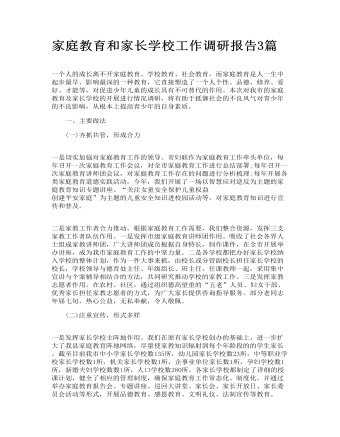
家庭教育和家长学校工作调研报告3篇
一是切实加强对家庭教育工作的领导。市妇联作为家庭教育工作牵头单位,每年召开一次家庭教育工作会议,对全市家庭教育工作进行总结部署;每年召开一次家庭教育讲师团会议,对家庭教育工作存在的问题进行分析梳理;每年开展各类家庭教育道德实践活动,今年,我们开展了一场以智慧应对逆反为主题的家庭教育知识专题讲座、“关注女童安全保护儿童权益创建平安家庭”为主题的儿童安全知识进校园活动等,对家庭教育知识进行宣传和普及。
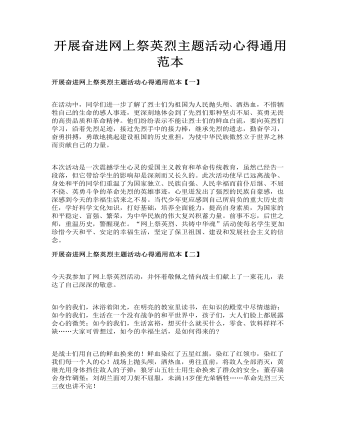
开展奋进网上祭英烈主题活动心得通用范本
本次活动是一次震撼学生心灵的爱国主义教育和革命传统教育,虽然已经告一段落,但它带给学生的影响却是深刻而又长久的。此次活动使早已远离战争、身处和平的同学们重温了为国家独立、民族自强、人民幸福而前仆后继、不屈不挠、英勇斗争的革命先烈的英雄事迹,心里迸发出了强烈的民族自豪感,也深感到今天的幸福生活来之不易。当代少年更应感到自己所肩负的重大历史责任,学好科学文化知识,打好基础,培养全面能力,提高自身素质,为国家的和平稳定、富强、繁荣,为中华民族的伟大复兴积蓄力量。前事不忘,后世之师,重温历史,警醒现在。“网上祭英烈、共铸中华魂”活动使每名学生更加珍惜今天和平、安定的幸福生活,坚定了保卫祖国、建设和发展社会主义的信念。
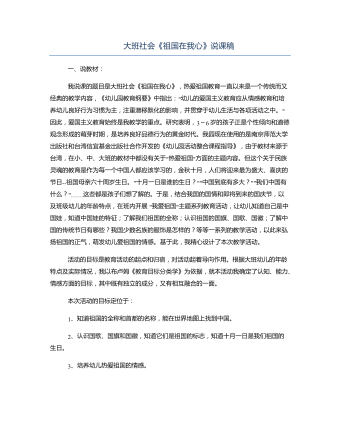
大班社会《祖国在我心》说课稿
我说课的题目是大班社会《祖国在我心》,热爱祖国教育一直以来是一个传统而又经典的教学内容,《幼儿园教育纲要》中指出:"幼儿的爱国主义教育应从情感教育和培养幼儿良好行为习惯为主,注重潜移默化的影响,并贯穿于幼儿生活与各项活动之中。" 因此,爱国主义教育始终是我教学的重点。研究表明,3~6岁的孩子正是个性倾向和道德观念形成的萌芽时期,是培养良好品德行为的黄金时代。我园现在使用的是南京师范大学出版社和台湾信宜基金出版社合作开发的《幼儿园活动整合课程指导》,由于教材来源于台湾,在小、中、大班的教材中都没有关于"热爱祖国"方面的主题内容。但这个关于民族灵魂的教育是作为每一个中国人都应该学习的,金秋十月,人们将迎来最为盛大、喜庆的节日--祖国母亲六十周岁生日。"十月一日是谁的生日?""中国到底有多大?""我们中国有什么?"……这些都是孩子们想了解的。
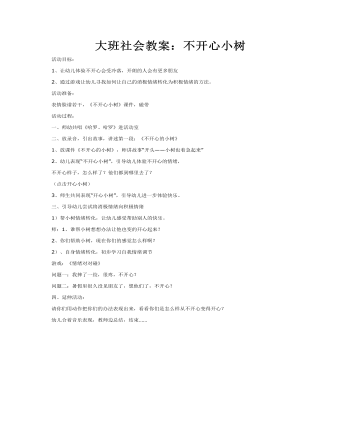
大班社会教案:不开心小树
一、师幼共唱《哈罗、哈罗》进活动室二、放录音,引出故事,讲述第一段:《不开心的小树》1、放课件《不开心的小树》,师讲故事“开头——小树也着急起来”2、幼儿表现“不开心小树”,引导幼儿体验不开心的情绪,不开心样子,怎么样了?他们都到哪里去了?(点击开心小树)3、师生共同表现“开心小树”,引导幼儿进一步体验快乐。
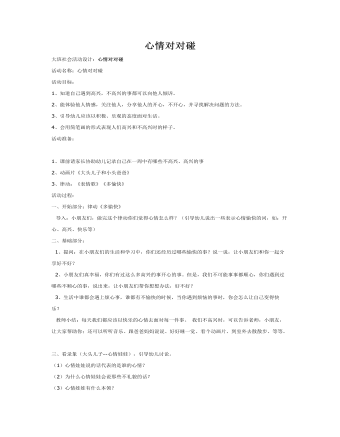
大班社会教案:心情对对碰
活动目标: 1、知道自己遇到高兴,不高兴的事都可以向他人倾诉。 2、能体验他人情感,关注他人,分享他人的开心,不开心,并寻找解决问题的方法。 3、引导幼儿应该以积极、乐观的态度面对生活。 4、会用简笔画的形式表现人们高兴和不高兴时的样子。 活动准备: 1、课前请家长协助幼儿记录自己在一周中有哪些不高兴、高兴的事 2、动画片《大头儿子和小头爸爸》 3、律动:《表情歌》《多愉快》 活动过程: 一、开始部分:律动《多愉快》 导入:小朋友们,做完这个律动你们觉得心情怎么样?(引导幼儿说出一些表示心情愉快的词,如:开心、高兴、快乐等)
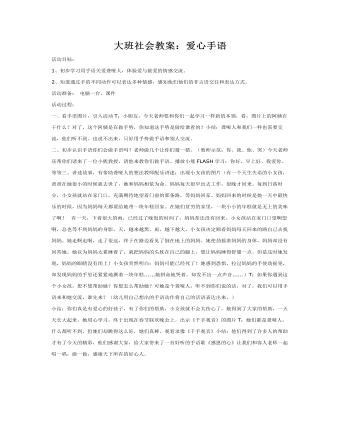
大班社会教案:爱心手语
活动过程:一、看手语图片,引入活动T:小朋友,今天老师要和你们一起学习一样新的本领,看,图片上的阿姨在干什么?对了,这个阿姨是在做手势,你知道这手势是做给谁看的?小结:聋哑人和我们一样也需要交流,他们听不到、也说不出来,只好用手势做手语和别人交流。二、初步认识手语你们会做手语吗?老师做几个让你们猜一猜。(教师示范:你、我、他、哭)今天老师还帮你们请来了一位小熊教授,请他来教你们做手语。播放小熊FLASH学习:你好、早上好、我爱你、等等三、讲述故事,有帮助聋哑人的想法教师配乐讲述:出现小女孩的图片(有一个天生失语的小女孩,爸爸在她很小的时候就去世了,她和妈妈相依为命。妈妈每天很早出去工作,很晚才回来。每到日落时分,小女孩就站在家门口,充满期待地望着门前的那条路,等妈妈回家。妈妈回来的时候是她一天中最快乐的时候,因为妈妈每天都要给她带一块年糕回家。在她们贫穷的家里,一块小小的年糕就是无上的美味了啊! 有一天,下着很大的雨,已经过了晚饭的时间了,妈妈却还没有回来。小女孩站在家门口望啊望啊,总也等不到妈妈的身影。天,越来越黑,雨,越下越大,小女孩决定顺着妈妈每天回来的路自己去找妈妈。她走啊走啊,走了很远,终于在路边看见了倒在地上的妈妈。她使劲摇着妈妈的身体,妈妈却没有回答她。她以为妈妈太累睡着了,就把妈妈的头枕在自己的腿上,想让妈妈睡得舒服一点。但是这时她发现,妈妈的眼睛没有闭上!小女孩突然明白:妈妈可能已经死了!她感到恐惧,拉过妈妈的手使劲摇晃,却发现妈妈的手里还紧紧地撰着一块年糕......她拼命地哭着,却发不出一点声音......)T:如果你遇到这个小女孩,想不想帮助她?你想怎么帮助她?可她是个聋哑人,听不到你们说的话,对了,我们可以用手语来和她交流,谁先来?(幼儿用自己想出的手语动作将自己的话语表达出来。)

